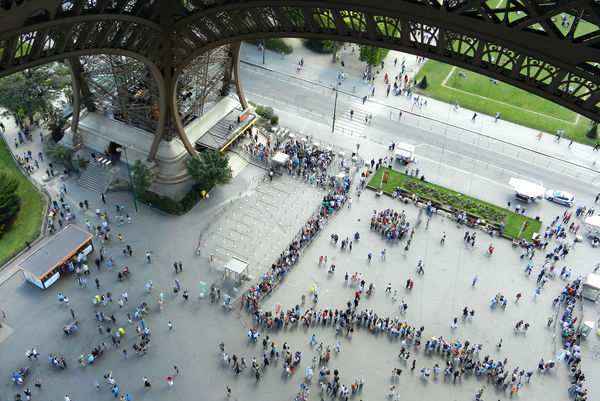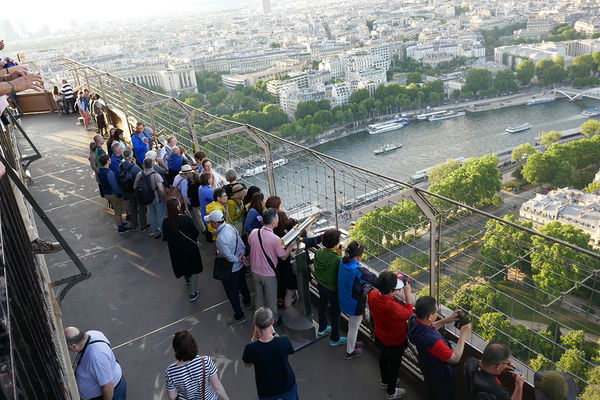The Eiffel Tower: Top Tips for Visitors
By Rick Steves

Going up the Eiffel Tower is one of the great travel thrills in Europe. Sure, it's crowded and expensive, and other spots in Paris offer (arguably) better views. But once you make the eye-popping ascent — and ear-popping descent — you'll be in the exclusive society of some 250 million people who have made the Eiffel Tower one of the most visited monuments in the world.
The first visitors ascended in 1889, the year the Paris World's Fair opened with the tower as its grand centerpiece. Put together like an 18,000-piece erector set, made of iron beams held together with 2.5 million rivets, the tower was a pure showpiece, with no functional purpose. It was meant to demonstrate to the world that France had the know-how and money to erect the tallest structure in the world.
Remarkably, the original plan was to dismantle the tower after 20 years. But designer Gustave Eiffel — an inveterate tinkerer — added a radio antenna and telegraph transmitters to the top, and the French government decided they'd made the tower too useful to tear down. (The French ended up using one of the transmitters to jam German radio communications during World War I.)
To visit this 1,000-foot-tall ornament today, you'll battle crowds and pay about $30 per person (for the elevator to the top) — but it's well worth it. Here are my tips for making it fun, time-efficient, and memorable:
Book tickets in advance. Those who just show up with no prebooked ticket are likely to waste lots of time in the initial entry line — in summer, waits of one to two hours are the norm (weekends and holidays can be worse). That's a shame, especially when it's fast, easy, and free to book a reservation online. Be sure to reserve well ahead for peak times, which includes most of the summer; dates open up 60 days out (at 8:30 Paris time), and can sell out within hours.
You'll need to take a few minutes to create an account (with your 10-digit mobile phone number as your login), and select your ticket according to how high up you'll go — and how. Ticket options include riding the elevators to the very top (I recommend getting this option; select "Lift entrance ticket with access to the summit"), riding only as far as the second level, or climbing the stairs to the first or second level (the top can only be reached by elevator). Be sure of your date, as reservations are nonrefundable. After paying with a credit card, you must either print your ticket (following the printing specifications carefully), or have the ticket's bar code texted to your smartphone. (Note that a ticket confirmation itself will not get you in — you must show your bar code, whether in print or on your phone — to be scanned when you enter.)
If slots are booked up, don't despair. If you're not that set on going all the way to the tower's top, try selecting the option on the tower's website for "Lift entrance ticket with access to 2nd floor" only, as these tickets may still be available when the tickets to the summit have been snapped up. On shorter notice — often available fairly last-minute — you can buy a reservation time for the second level for about $65 by joining one of Fat Tire Tours' "Skip the Line" Eiffel Tower tours (price includes Eiffel Tower ticket to the second level). And you can bypass some (but not all) entry lines if you've booked a table at either of the tower's classy view restaurants (Madame Brasserie or the even pricier Jules Verne).
If going to the summit is important to you, try again online about a week ahead of your visit, as last-minute slots occasionally open up.
Without a reservation at all, try showing up early (about 30 minutes before the tower opens), late (after 7 p.m. May–August, after 5 p.m. in spring and fall, or after 4 p.m. in winter), or in less-than-ideal weather — lines evaporate in the rain.
Consider your timing. For the best of all worlds, plan to arrive close to sundown to see the views, then stay as it gets dark to see the lights. At the top of the hour, a five-minute display features thousands of sparkling lights lassoing the tower (best viewed from below, either from right across the river at Place du Trocadéro, or the grassy park just under the tower). However impressive it may be by day, the tower is an awesome thing to behold at twilight, when darkness fully envelops the city, and the tower is resplendent with its spectacular light show.
And expect to be there for a while — in summer I'd budget three to four hours for the time it takes to wait in line, get to the top, and enjoy the views and exhibits on your way back down. (The quickest you could get to the top and back — with a reserved ticket, lesser crowds, and minimal sightseeing — would be about 90 minutes.) If you have a reserved entry time, arrive about 30 minutes ahead.
Keep your valuables out of reach. Street thieves plunder awestruck visitors gawking below the tower, and tourists in crowded elevators are like fish in a barrel for predatory pickpockets. Wear a money belt or some other means of keeping your cash and cards tucked away under your clothes, and be thoughtful about where you keep your phone.
Sightsee from top to bottom. The tower has three levels with observation platforms, at roughly 200, 400, and 900 feet, all connected by elevators and stairs. But there isn't a single elevator straight to the top (le sommet). To get there, you'll first ride an elevator (or climb 775 steps) to the second level. (Some elevators stop on the first level, but don't get off — it's more efficient to see the first level on the way down.) Once on the second level, immediately line up for the next elevator, to the top. (Look for the shortest line; there are several elevators and feeder queues.)
Keep an eye out for the secret apartment! Few people realize that Gustave Eiffel built himself a little hideaway apartment on the top level of the tower. Eiffel used the plush space for quiet reflection and occasional visitors, and resisted all offers to rent it out. (Visitors can peer inside the still-furnished space.)
The peak experience is halfway down. By all means, go to the top if you have the time (skip it if your schedule's tight). But I prefer to linger on the second floor: For me, the best views are from this middle level — high enough to see all of Paris, but low enough to pick out distinguishing landmarks. And don't skip the first level: Explore its shops and exhibits, then venture onto its vertigo-inducing glass floor to experience what it's like to stand atop an 18-story building.
Save time by taking the stairs down. The tower is notorious for its elevator lines — both up and down. I'll tolerate the lines to ride the elevator up, but I prefer to take the stairs down. You'll need to take the elevator from the top down to the second level, but can use the stairs down from there. It takes about five minutes to walk between each level — much faster than the elevator line and a far more memorable way to return to earth.
Once back on the ground, you'll appreciate the tower's romance and engineering even more. For a final look, stroll across the Seine River to Place du Trocadéro, and look back for great views of the defining symbol of Paris.

